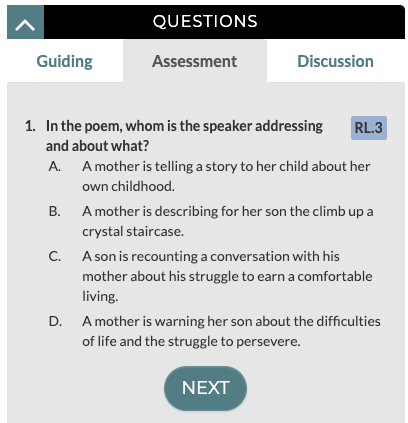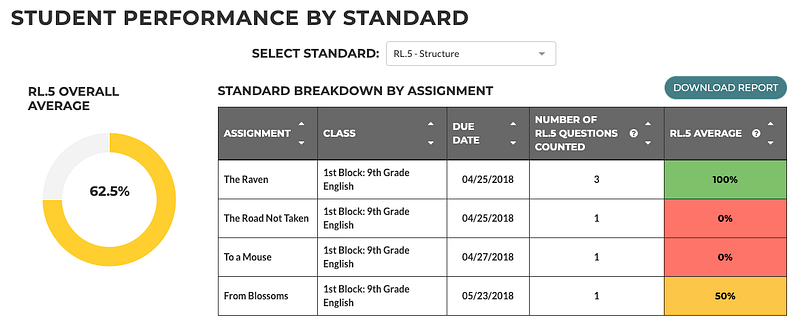Leverage CommonLit’s standards data for individual students
The most important thing for a teacher to know is how her students are doing. A good teacher understands this, and has a clear sense of what students can do (and can’t do) at any point in the year.
So, how are my students doing? Are they meeting the standards? What do I do next if they aren’t doing well? At CommonLit, we have done our best to build free performance tracking tools to help teachers answer these important questions in a meaningful way.
In this article, expert teachers and data scientists on CommonLit’s staff break down some best practices on how to make meaning of CommonLit’s Standards Performance charts and use the data to make strong instructional decisions.
What skills do standards address?
CommonLit displays student performance on Common Core Literary (RL) and Informational (RI) standards. While the language of some states’ standards can differ from the Common Core, most states’ English standards address these basic underlying skills:
- Finding Evidence (RI.1/RL.1)
- Central Idea/Theme (RI.2/RL.2)
- Interaction of Ideas/Characters (RI.3/RL.3)
- Language & Vocabulary (RI.4/RL.4)
- Structure (RI.5/RL.5)
- Point of View (RI.6/RL.6)
- Multimedia (RI.7/RL.7)
- Argument (RI.8)
- Comparing Texts/Genres (RI.9/RL.9) Note: For high schoolers, RI.9 also covers understanding Seminal United States documents.
On CommonLit, you can switch from viewing Common Core standards to Florida State Standards by editing your preferences on your My Account page. Interested in seeing your state’s standards added to CommonLit? Have your administrators reach out to partnerships@commonlit.org.
How does CommonLit assess these standards through an assignment?
Each CommonLit assignment comes with a standards-aligned assessment which includes 5+ questions. Each question in the assessment is tagged with a particular standard: RL.1–10 for Literary texts, and RI.1–10 for Informational texts. The items are written in the style of a state assessment using similar question stems and language. To see what standards are assessed in a CommonLit assignment, simply look for the blue standards box to the right of the question.

What standards data can I find on the Student Performance pages?
The most basic data you can find regarding standards is students’ average by standard. In other words, you can see the what percent of questions tagged with a particular standard students are getting right. On CommonLit, you can access this information for a particular student on their Individual Student Performance page. You can get there from the Student Performance page by clicking the class the student is in, then clicking the student’s name.
Additionally, you can see these averages broken down by assignment along with contextual information on how much they’ve worked with the standard.

The Class Performance pages also contain valuable standards information, which you can learn about here.
How do I interpret the standards data on the Individual Student Performance page?
Now that you’ve collected the data, you need to interpret what the chart is showing you. We’ve compiled a list of recommendations from our data scientists and literacy experts to help you:
Recommendation 1: Check How Many Times a Standard Has Been Assessed
While, averages on a standard provide a helpful snapshot of how classes or students are doing on certain types of questions, we recommend that teachers always dig deeper and check how many items are being assessed for a standard before drawing conclusions. Data on standard performance is always more reliable when a student has answered more questions about that standard. It is difficult to know how a student is doing if they have only answered one RL.2 question as opposed to having answered ten.
We recommend waiting to analyze student performance on a standard until a student has answered at least five items for that standard. If a student has answered fewer than five items on that standard, it’s best to collect more data before making a decision of how to proceed.
Recommendation 2: Consider the Context of the Assignment
It’s also important to consider the context of the assignment. First, was the assignment in a new genre that the student is seeing for the first time? Was the assignment appropriate for a student’s grade level? Were students completing the assignment independently in a silent room, for homework, with partners, or alongside a tutor? These are all legitimate and recommended ways to implement a CommonLit assignment. However, it’s important to note that these factors can influence performance. Alison Siegel, a data scientist at CommonLit, explains “to actually measure a standard, you’d need to assess students on it several times under the same conditions.” She recommends using standards performance data from the individual student performance page “in conjunction with other information teachers have about their students” to assess how well they’re doing.
You can also analyze your data based on specific end goals. If your goal is to determine what a student can do independently, we recommend giving more weight to assignments that were completed independently. If you create class assignments for group work and individual assignments for independent work, you can filter the chart by individual assignments on the left of the page.
How would a really good teacher use CommonLit’s Standards Performance data?
We asked our Chief Academic Officer, Anna Hodges, how she’d analyze the data for the individual 9th grade student in the image below.

“First, I want to make sure there are enough items in the sample,” Anna said. “Since the student has answered six RL.5 questions so far — that’s more than five — we can begin to draw meaningful conclusions from the data.”
“Next, I’d want to go into each assignment and actually take a look at the stems for each RL.5 question the student answered to help me to determine where exactly the student was struggling. This is important because standards assess many different sub-skills.”
Anna can go to the assignment report for any of these assignments to analyze their question stems. To get there, she should click the assignment name in the Submitted Assignments table at the top of the Individual Student Performance page.
Through this analysis, Anna discovered that in “The Road Not Taken” (8th grade poem) and “To a Mouse” (9th grade poem), the RL.5 questions ask how particular sections of the poems contribute to the overall meaning of the poem. This student scored 0% on both these questions.
Anna also remembers that “From Blossoms” (8th grade poem) was assigned as group work rather than independent work and that the bell rang before most students could finish it. It was a useful lesson, but since this short answer question was answered under much different conditions than the other RL.5 multiple choice questions affecting the average, Anna decides to throw this item out of her analysis. Meanwhile, in “The Raven,” (9th grade) there were three RL.5 questions that asked how the particular structural choices of allusions, repetition, and rhyme contribute to affects such as characterization, mood, and tone, respectively. This student scored 100% on these three RL.5 questions.
“It looks like the question stems that this student tends to miss are about how a particular line or stanza contributes to the text’s overall structure. Based on this analysis, I know that this student is likely struggling with text structure,” Anna said. “Because these questions only assessed RL.5 for poetry, I have to be careful not to over-interpret this data and apply it to all genres including short stories and informational texts. A poem is a different beast altogether!”
What can I do to help my students with standards?
As teachers drill down into each standard, they will often find that students need more exposure and practice with specific skills. We asked our curriculum team for some concrete ideas for helping students on skills. Here are some of their ideas:
1. Introduce a Graphic Organizer: Graphic organizers are powerful tools to help teachers break down skills into manageable steps for students.
2. Explicitly Teach or Reteach a Skill: Sometimes, students don’t understand what a question is asking and need a refresher. In an ideal skill lesson, the teacher would explain the skill (for example, finding the mood of a poem), model the skill for the whole class on a text, lead guided practice on the skill for the remainder of the text, and check in on student understanding throughout the practice to correct misunderstandings.
3. Facilitate Meaningful Group Work: Grouping students can be a great way to differentiate instruction and get more 1:1 time with students who are still struggling on a particular skill. This would be a great time to work on a graphic organizer with a small group of students and offer extension work for students who are performing well.
What other testing resources does CommonLit have for schools and districts?
Are you a school or district admin who is interested in assessing psychometrically valid standards performance for students in a secure testing environment? If so, check out CommonLit’s Interim Assessments on our School Essentials page. Email partnerships@commonlit.org to learn more.

